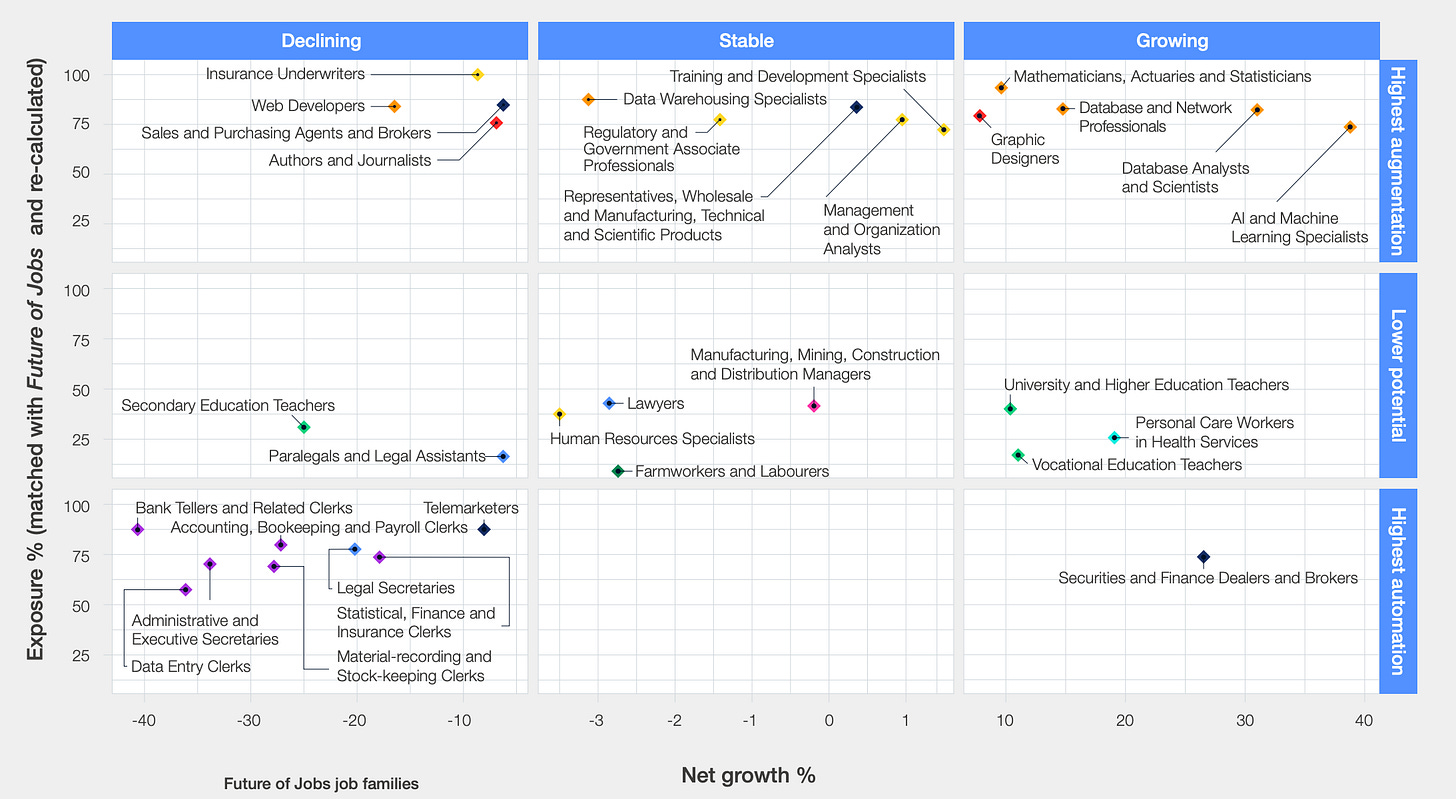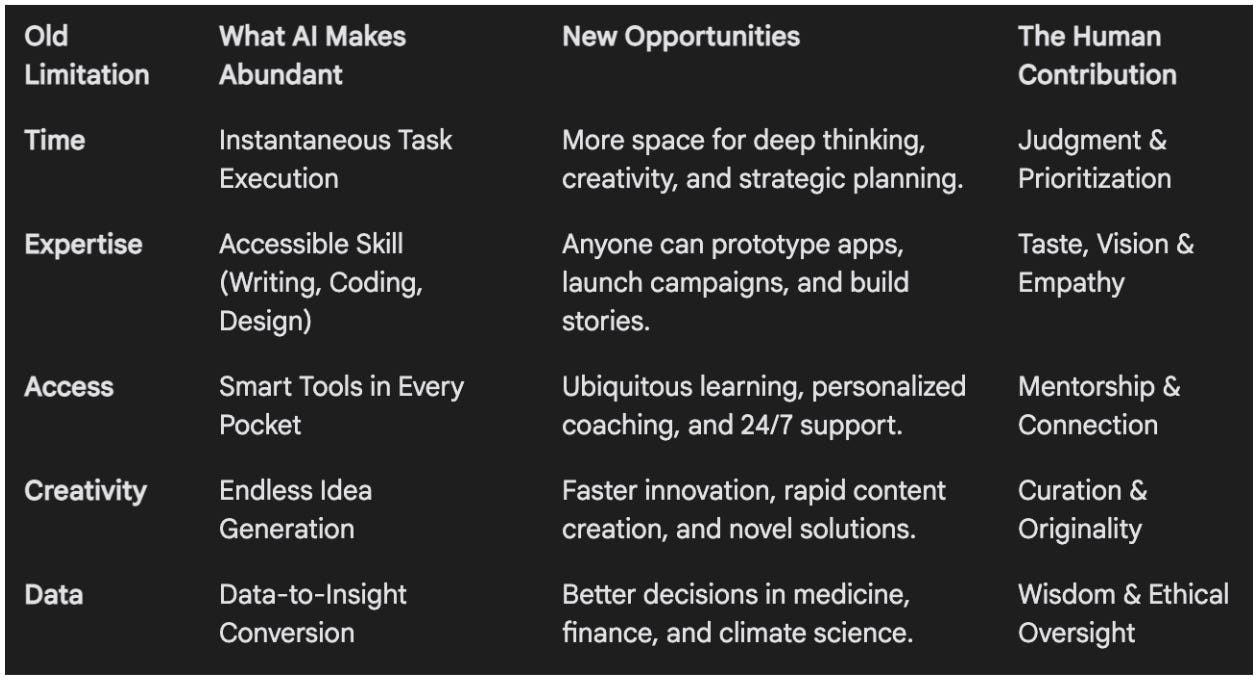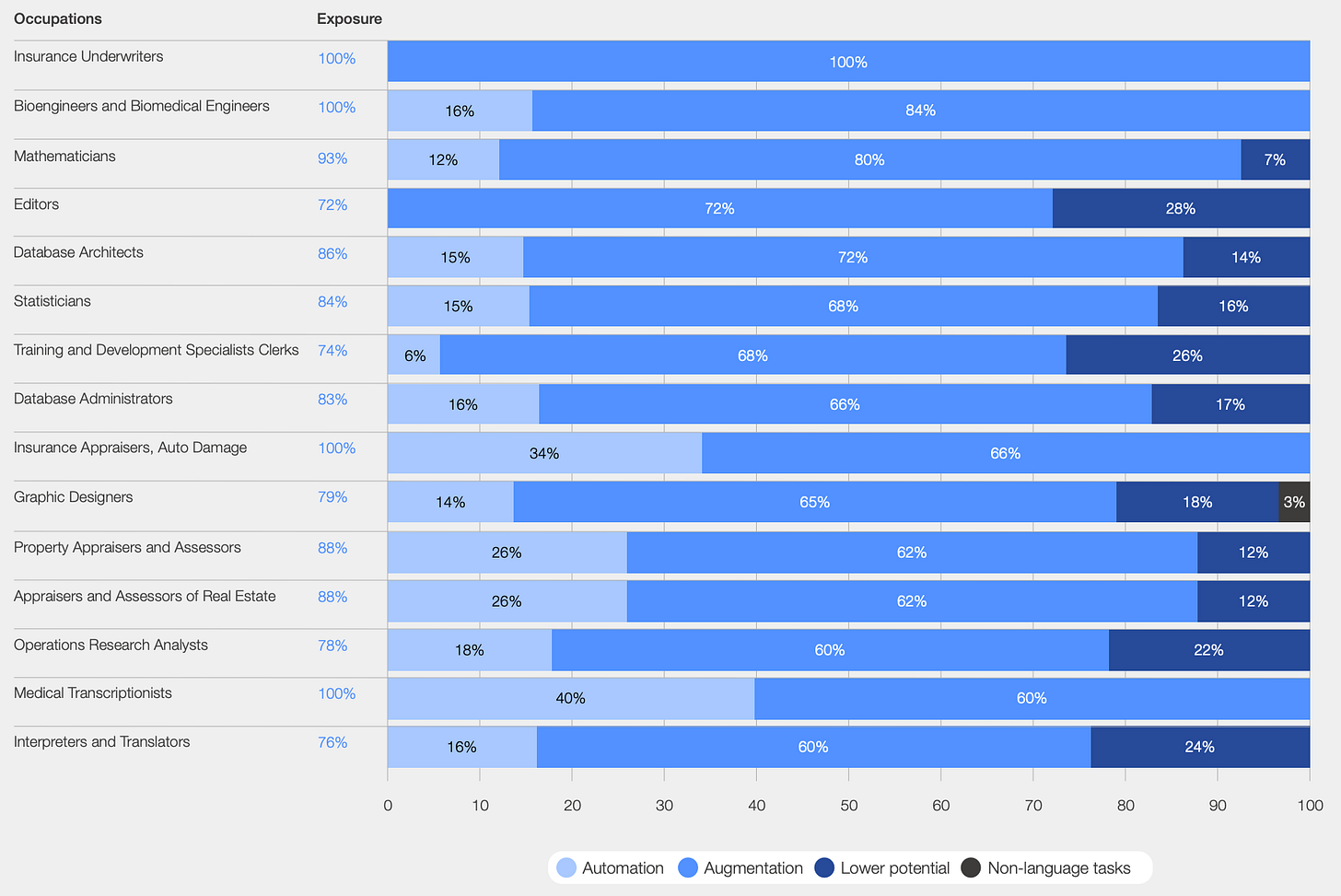Secret Pattern Every Game-Changing Technology Follows
What Past Technologies Teach Us About AI's Future
Learning from History
You need to study historical patterns to predict the future. We take our 9-to-5 work style for granted, but it’s a relatively recent invention, codified by policies like The Fair Labor Standards Act of 1938 and cemented in culture by the post-WWII boom in office work.
Work was not bound by a clock before the Industrial Revolution. Labor was tied to natural rhythms, seasons, and immediate survival needs for the agrarian, craft-based, and domestic workers. The factory whistle and the office block were the technologies that created the modern workday. Now, a new technology—Artificial Intelligence—is poised to orchestrate an even greater shift.
Source: PwC
Theory of Abundance
The Theory of Abundance says that when a breakthrough technology makes something cheaper, faster, or easier then it doesn’t just replace old things — it unleashes massive new demand and innovation (Science Direct).
How Past Technologies Followed This Pattern
History shows that when a breakthrough technology makes a resource dramatically cheaper, faster and more accessible. It doesn’t just replace the old way of doing things—it unleashes a wave of new demand and innovation. This is the Theory of Abundance.
Source: PwC
Cars Made Travel Fast and Cheap
This didn't just replace the horse but created suburban life, the national highway system and the tourism industry. It created an abundance of mobility.
New jobs emerged: auto mechanics, gas station attendants, taxi drivers, truckers, automotive engineers and highway construction workers.
Computers Made Calculation and Office Tasks Instant
This didn't just replace typewriters but enabled businesses to scale globally which led to a boom in digital services. It created an abundance of productivity.
New jobs emerged: computer programmers, system administrators, IT support specialists, database managers and software engineers.
The Internet Made Information Free and Distribution Instant
This didn't just replace libraries but empowered anyone to be a creator, seller and coder, giving birth to the creator economy. It created an abundance of access. There were limited number of channels earlier and difficult for creators to publish their work.
New jobs emerged: web developers, digital marketers, content creators, cybersecurity specialists, and e-commerce managers.
Electricity Made Power Portable and Controllable
This didn't just replace candles and gas lamps but enabled mass production, skyscrapers, and 24/7 operations. It created an abundance of energy.
New jobs emerged: electricians, power plant operators, electrical engineers, appliance repairers and utility workers.
Refrigeration Made Food Preservation Effortless
This didn't just replace ice harvesting but enabled global food distribution, restaurant chains, and year-round fresh produce. It created an abundance of freshness.
New jobs emerged: refrigeration technicians, cold storage operators, food logistics coordinators, and appliance manufacturers.
Aviation Made Long-Distance Travel Routine.
This didn't just replace ships for passenger travel but created global business networks, international tourism, and same-day delivery. It created an abundance of reach.
New jobs emerged: pilots, flight attendants, air traffic controllers, aircraft mechanics, and airport security personnel.
Smartphones Made Communication and Computing Portable. This didn't just replace landlines but enabled the gig economy, location-based services, and instant global connectivity. It created an abundance of connection.
New jobs emerged: app developers, ride-share drivers, mobile repair technicians, social media managers, and UX designers.
How AI Will Unlock New Abundance
AI Needs a Co-pilot
While headlines proclaim "AI Replacing Jobs," the reality is more nuanced. From over two years of hands-on experience with AI products, it's clear that AI's value is dramatically limited without human guidance. An AI on its own is a powerful engine without a steering wheel; it requires context, strategic direction, and critical oversight to create real value.
Its core limitations are not failures, but rather a clear job description for the modern professional:
The Hallucination Problem: AI can generate convincing but completely fabricated information, from citing non-existent research papers to creating false historical facts. Humans are needed as fact-checkers and truth arbiters.
The Bias Problem: Trained on human-generated data, AI inherits and can amplify societal biases, leading to discriminatory outcomes in hiring, lending, and justice. Humans are needed to ensure fairness, equity, and ethical application.
The "Black Box" Problem: A lack of transparency makes it difficult to understand how an AI reaches its conclusions. This is unacceptable in critical fields like medicine or law. Humans are needed to demand and interpret explainability.
The Context-Free Problem: AI struggles with nuance, edge cases, and changes in the world not reflected in its training data. Humans are needed to apply real-world context and common-sense reasoning.
Bullet-Proof Jobs
1. Deathcare Workers (Morticians, Embalmers, Funeral Directors)
Why AI struggles: Death is both a logistical challenge and an emotional experience. Families want empathy, tradition, and personal care. No one wants an AI to conduct a funeral or preserve a loved one’s body. This field involves taboo topics, cultural rituals, and emotional subtlety that AI isn’t equipped to handle.
Bonus twist: As populations age, this industry is growing—and no startup is rushing to "disrupt" it with automation.
2. High-Stakes Negotiators and Crisis Mediators
Why AI struggles: Negotiation—especially in high-tension situations like hostage crises, labor disputes, or international diplomacy—relies on reading micro-signals, understanding hidden motivations, and adapting in real time. These roles require improvisation, persuasion, and intuition.
Bonus twist: AI can provide intel and support, but humans are still the ones trusted to de-escalate chaos.
3. Luxury Service Providers
Examples: Private chefs, personal concierges, bespoke tailors, sommeliers, yacht crew, high-end butlers.
Why AI struggles: Wealthy clients don’t want automation—they want human expertise, discretion, and personalized service. AI can recommend a wine pairing, but it can’t deliver it with charm and theatrical flair in a five-star restaurant.
Bonus twist: In elite service economies, the human touch becomes more valuable as everything else becomes automated.
4. Wilderness Guides and Survival Experts
Why AI struggles: GPS, drones, and smart gear help, but deep wilderness is unpredictable. Guides must make judgment calls under pressure—based on weather, terrain, group dynamics, and instincts honed over time. You can't debug a grizzly bear.
Bonus twist: As urban life becomes more digital and detached, the demand for authentic nature experiences—led by real humans—is growing.
5. Spiritual Leaders and Philosophers
Why AI struggles: AI can quote scripture, simulate wisdom, and even generate meditative chants—but it doesn’t believe anything. It lacks consciousness, conviction, and soul. People seek guidance from those they see as spiritually authentic, not programmed.
Bonus twist: In a world full of synthetic voices, people crave the real thing—especially when searching for meaning, purpose, or healing.
6. Niche Hobby Artisans and Restoration Experts
Examples: Pipe organ tuners, antique book restorers, stained-glass artists, luthiers (violin makers), horologists (watch repairers).
Why AI struggles: These jobs often involve obscure knowledge, hands-on craftsmanship, and immense patience. Machines don’t have the dexterity or historical context to restore a 300-year-old violin or Gothic cathedral window.
Bonus twist: As mass production and digital media dominate, there’s a renaissance in rare, slow, and analog arts.
7. Professional Witnesses and Courtroom Performers
Examples: Trial lawyers, jury consultants, expert witnesses, courtroom sketch artists.
Why AI struggles: Legal AI can analyze case law, but trials are theater. Juries respond to charisma, tone, and trust. Skilled litigators read the room, pivot on the fly, and emotionally influence outcomes. It’s performance as much as logic.
Bonus twist: AI might help prepare a case, but the best lawyers still win it in the room—face to face.
Jobs That Will Thrive or Emerge from the AI Boom
Health & Wellness
AI Health Coach
Like a fitness trainer, but with help from AI. They use data from your smartwatches, health apps, and AI suggestions to help people eat better, sleep better, and live longer.
Medical AI Checker
Doctors will still be around, but someone needs to double-check the AI when it helps diagnose people. This job makes sure AI doesn’t mess up with people’s health.
School & Learning
Smart Learning Designer
School won’t be one-size-fits-all anymore. These people build apps and lessons that adjust to how you learn best — like a personal tutor powered by AI.
AI School Coach
This person helps teachers and students get the most out of AI-powered tools in the classroom, without cheating or losing real learning.
Entertainment & Creativity
Virtual Game Storyteller
Games are getting smarter. This job mixes writing and tech to create games where the story changes based on how you play.
Music & Art AI Collaborator
Artists will use AI to remix, design, or write things faster. These people help make sure the AI art is unique and feels human.
Deepfake Police
As fake videos get more real, this job will focus on spotting and stopping fake news, fake voices, or fake celebrities made by AI.
Jobs & Business
Chatbot Voice Designer
AI is talking to customers now — in shops, banks, websites. This job builds the tone and personality of those bots so they’re helpful, not creepy.
Ad Personalizer
Ads are getting smarter. These people use AI to help companies show you exactly what you want to see — but ethically.
Online Safety Tester
When businesses use AI to make decisions (like hiring someone), these people test if the AI is being fair or biased.
Nature, Farming & the Planet
AI Farm Drone Operator
Drones flying over fields are checking plants, spraying only where needed. Someone needs to run and fix them — and that’s this job.
Green Tech Modeler
These people use AI to predict floods, wildfires, and other climate stuff — then help make better plans to deal with them.
Society, Law & Government
AI Law Helper
Lawyers will use AI to read thousands of pages fast. This job checks the AI’s work so people don’t go to jail by accident.
Fairness Checker
Some AI tools might treat people unfairly — like giving fewer job offers to certain groups. This job makes sure that doesn’t happen.
Tech, But in Cool Ways
AI Prompt Engineer
Basically a professional “AI whisperer.” They know how to ask the perfect questions or write the best prompts so AI gives useful answers.
Digital Twin Builder
Imagine making a virtual copy of a city, car, or person to test things on. These people make that digital twin and let AI run experiments.
The Augmentation Effect
The most significant finding across the research is that AI's primary impact will be augmentation, not automation. Rather than replacing workers, AI will act as a powerful tool that enhances their capabilities, automates routine tasks, and frees them up to focus on higher-value strategic work.
Source: World Economic Forum
The WEF and Accenture's "Jobs of Tomorrow" report powerfully illustrates this in its "Job exposure vs growth potential" chart. It shows a clear correlation: jobs with the highest potential for augmentation are overwhelmingly concentrated in the high-growth quadrant.
This creates demand for roles that can effectively partner with technology:
Digital Transformation Specialists: These experts help organizations strategically integrate AI into their workflows to boost efficiency and create value.
Business Intelligence Analysts: Augmented by AI tools, these analysts can sift through unprecedented amounts of data to provide deeper, more accurate insights for business strategy.
AI-Driven Business Development Professionals: Using AI for market analysis and lead generation, these sales and growth experts can identify and pursue opportunities with greater precision and speed.
The New Frontier: Governance, Ethics, and Human-AI Interaction
As AI technology matures, a new class of jobs is emerging to manage its implementation, ensure its ethical use, and refine how we interact with it. These roles form the crucial "support layer" for a responsible AI ecosystem.
Emerging jobs in this space include:
AI Ethics and Governance Specialists: These professionals will be tasked with creating frameworks to ensure AI systems are fair, transparent, and free of bias.
Prompt Engineers: A role that has exploded with the rise of generative AI, prompt engineers specialize in crafting the precise inputs needed to get the most accurate and useful outputs from Large Language Models (LLMs).
Data Curators and AI Trainers: These individuals are responsible for the quality of training data, ensuring it is clean, relevant, and ethically sourced. They play a vital role in preventing the "garbage in, garbage out" problem with AI models.
AI Interaction and UX Designers: These designers will create the intuitive interfaces that allow everyone, not just tech experts, to use powerful AI tools effectively.
The Ripple Effect: AI's Impact Across Industries
The AI job boom is not confined to the tech sector. AI's capabilities are creating new roles and enhancing existing ones across every industry.
Source: World Economic Forum
In Sustainability: The WEF's "Future of Jobs" report identifies Sustainability Specialists and Renewable Energy Engineers as high-growth roles. These professionals will use AI to optimize energy grids, model climate impacts, and develop more efficient green technologies.
In Finance: FinTech Engineers are leveraging AI to build automated trading platforms, sophisticated fraud detection systems, and personalized financial planning tools.
In Creative Fields: AI Content Creators are emerging as professionals who can use generative AI to rapidly produce high-quality marketing copy, articles, design assets, and training materials, transforming creative workflows.
The Mandate for Change: Reimagining Education for a World That Now Exists
The most profound challenge is not in the job market, but in our preparation for it. The modern university curriculum is a slow-moving beast designed for a pre-AI era of knowledge transfer, and it is failing for three key reasons:
Teaching for Jobs at Risk
Universities are effectively selling a four-year, $200,000 preparation for entry-level jobs (document summarization, basic analysis, formulaic writing) that a $20/month AI subscription can increasingly perform.
Emphasis on "What" over "How"
The old system excelled at teaching students what to know (theories, facts, formulas). But AI is now the ultimate repository of "what." The value is no longer in knowing information but in how to use it—critically, creatively, and ethically.
Mismatched Pace of Change
A university committee might take two years to approve a new course, by which time a new generation of AI will have rendered its skills obsolete. The four-year degree structure is fundamentally mismatched with the exponential pace of technology.









